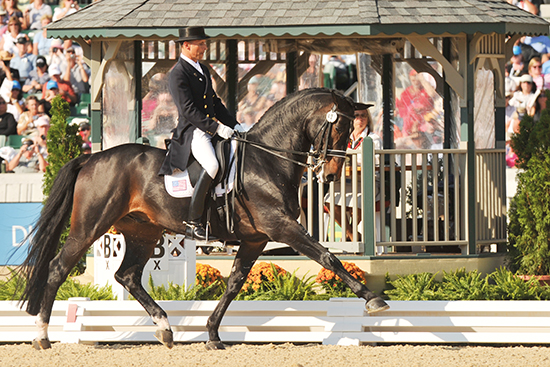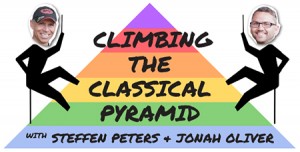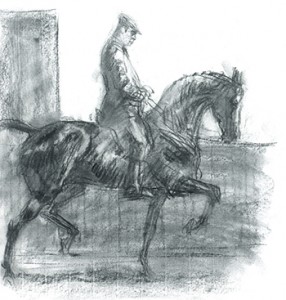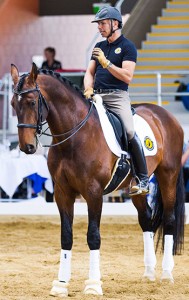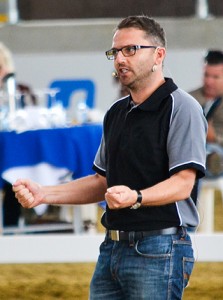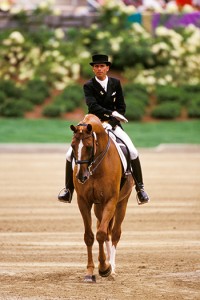Welcome back to part three of the seven-part series covering the three day Ultimate Masterclass with Olympic rider and trainer, Steffen Peters and sports psychologist Jonah Oliver.
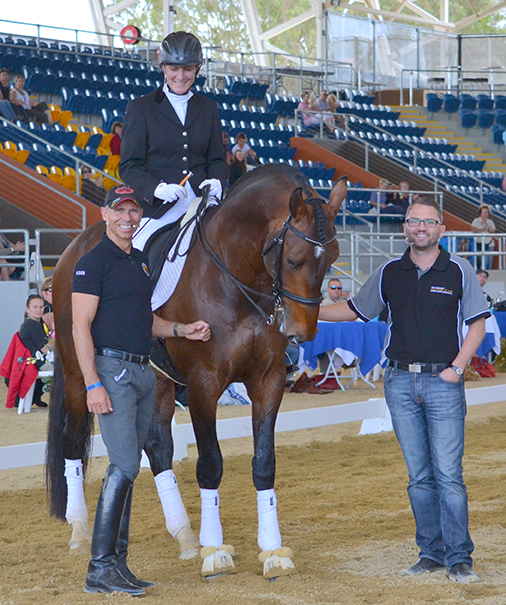
Steffen and Jonah with this episode’s ‘customers’
– Dolly Joyce and Roosendaal BFD
As I’m sure you are all well aware THM have been following the progress of six horse and rider combinations as they work through the successive steps of the classical dressage training pyramid.
Last issue we profiled Harvey Besley and his horse Bloomfield Sorrento as they concentrated on the second step of the pyramid: relaxation with elasticity and suppleness. The important lesson from this training level is that achieving a relaxed, elastic and supple horse is an ongoing process; it is certainly not achieved overnight. To successfully develop the horse’s physical and mental state takes both time and dedication. However, with thoughtful insights from Steffen and Jonah it became clear that this process can progress a little more quickly by possessing a greater awareness of our emotional response to stress as a rider; how that in turn affects our horse; and setting higher standards at the very outset of training and then maintaining these standards with absolute and utter consistency.
Jonah discussed the neuropsychology of fear and the difference between fight or flight riders. For many of us, performance anxiety is enough to trigger the fight or flight response. Riders in a flight state want to run away, have jelly or tense legs, rendering the lower body less effective; conversely the fight mode engages the upper body where muscles become tense in the neck, chest and hands. Understanding your personality type is an important key to unlocking your individual approach to training effectively and then implementing strategies that will allow you to compete more effectively.
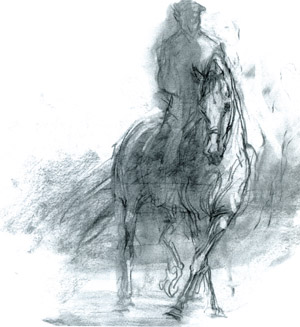
“If a Man knows all things but has no ‘feel’ that is disaster.”
Nuno Oliveira
The Classical Dressage Training Pyramid
Contact – Steady, Light and Even
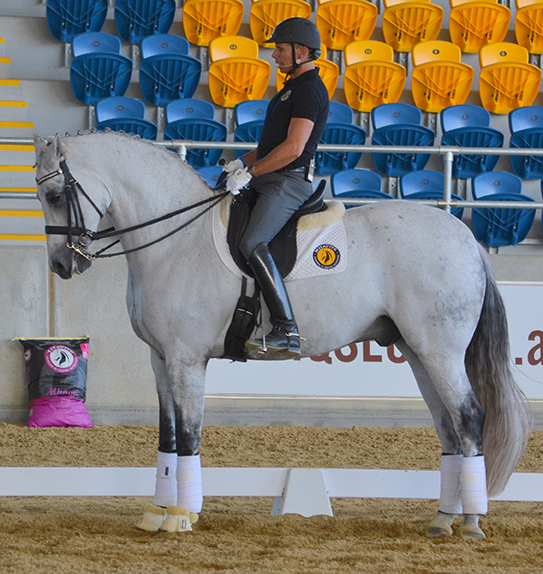
Stefan riding Dante showing light even contact – notice how he is only using the snaffle rein of the double bridle
Contact is an holistic flow of energy. The energy from the rein contact that is applied without the supporting contact from the legs and seat has ‘input’ but no channel for ‘output’, therefore the rein aid will often dissipate before reaching its destination. One of the most fundamental mistakes riders make is assuming that contact simply means ‘having the horse on the bit.’ This implies that contact is achieved only through the reins and therefore we ride with our hands alone. When a horse is moving under a rider he is in actual contact with the rider’s leg, seat and hands.
Correct contact therefore is when a horse is accepting and responsive to all the contact aids: it moves freely forward with a swinging back (relaxation); maintains an even tempo (rhythm) and assumes a rounded outline with a mouth that is both relaxed and accepting of the bit. In this frame his back will be rounded, his quarters engaged, his poll the highest point, his jaw relaxed and his nose slightly in front of the vertical.
If a rider tries to prematurely bring a horse “onto the bit”, by shortening the reins thus attempting to pull the horse head into a vertical position, before it is sufficiently relaxed (supple and loose) the tempo of the gait will be lost. Any attempt to drive the horse forward at this stage with the legs will result in the horse hollowing his back, shortening his strides, falling out of balance and adopting an unresponsive, stiffly held head carriage. The horse will now attempt to resist the bit, collapsing the entire training pyramid like a house of cards.
When the horse is working rhythmically forward from the leg and seat aids he should seek contact with the rider’s hand, where his poll is the highest point of the neck; under these conditions the horse can now find his balance under the rider in each of the gaits. Steady, light and even contact means contact through quiet, soft steady hands and giving fingers. The feeling in each hand should be the same; quiet legs, draped around the sides of the horse with the weight of a wet towel and a balanced independent seat, which moves with the horse.
Interview with Dolly Joyce riding Roosendaal BFD
The third horse and rider combination is Bianca (Dolly) Joyce and the young Holsteiner stallion Roosendaal BFD (Bean), owned by David and Dolly Joyce and his breeder, Louise Van Gaal of Brokeford Holsteiners. Bean is by the Showjumping sire, Rabino, out of a Romedio mare and the initial plan was for him to broken in and campaigned by Dolly’s husband David as a showjumper.
In many ways Dolly represents a large majority of dressage riders who have had to combine riding as a somewhat indulgent hobby whose primary focus has been, along with David, running the family organic dairy farm and raising their children. I asked Dolly to describe a little of her aspirations for her riding and what she hopes to achieve during the Masterclass with Steffen and Jonah:
“I am an amateur rider that has only recently trained to this level, so I am blown away by the opportunity to work with Steffen and Jonah. I have always dabbled with dressage but in adult riding clubs and my only EA experience was at Preliminary level until two years ago.”
What is it like to ride a stallion?
“I had never ridden a stallion before and didn’t really have any intention of doing so but as soon as Bean was broken in and I watched him start his jump training I really wanted to ‘have a sit’ on him. I began riding him slowly as I was initially intimidated by his size and the fact that he is a stallion. However, I eventually convinced my husband that a bit of dressage training might help strengthen the young horse and eventually David just stopped jumping him. Louise saw my partnership with Bean developing and was happy for me to train him in dressage instead.”
Contact is the steady, light and even connection between the rider’s hand and the horse’s mouth. Contact is communication; communicating is feeling.
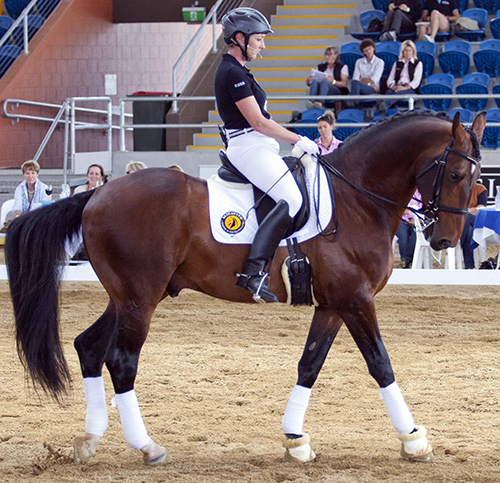
Although Dolly is driving with the legs and seat aid, the communication is lost due to ineffective rein contact. Bean has tucked in his chin and is not stepping underneath himself adequately with his hind legs
How did you start training with Nicole Magoffin?
“In November, 2010 I attended a Nicole Magoffin dressage clinic in Darnum, Victoria. I had admired Nicole as a rider and was well aware of her training with Steffen Peters so I was really keen to go to the clinic. What followed has been a life changing experience for me as I have learnt so much and am feeling now that my childhood fantasy of training a horse to Grand Prix may actually become a reality.”
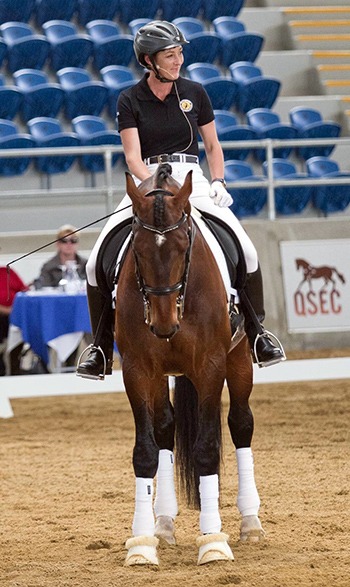
What are you hoping to learn from Steffen at the Masterclass?
“As these movements are new to me I am hoping Steffen can show me how to polish the moves with expression without sacrificing the harmony. When I watch Steffen ride Ravel at Grand Prix I love the soft and supple picture he gives with horse and rider working happily as one.”
How do you feel Jonah can help you?
“Like most riders I suffer from competition anxiety. I tend to fry myself prior to getting on the horse and then once I am on, I always seem to ride safe in the competition arena rather than ride to my and Bean’s ability. I am really hoping Jonah can help me with my emotional state before and during the competition. I am also hoping that Jonah can help my anxiety of riding before Steffen so I can get the most out of the clinic.”
“Gentleness. Is it worthwhile? Yes, always! Yes, it is worthwhile
to ‘put on bedroom slippers’ as Baucher advises and to try
to ride all horses, without exception, using the reins and the legs with the utmost gentleness and the least effort.”
Nuno Oliveira
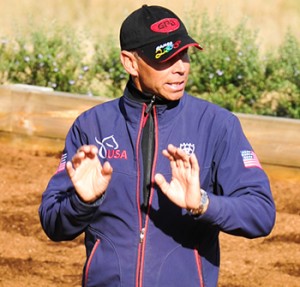 Steffen on Contact
Steffen on Contact
Dolly and Bean have entered the arena and are walking quietly; Steffen has asked Dolly to trot a 20 metre circle. He notices immediately that Dolly has a very soft rein contact but is not achieving the required level of engagement as her horse is not forward of her leg.
Steffen asks Dolly to lengthen Bean’s stride and while he praises her soft hands, he also challenges her to raise her training standards by keeping Bean forward of her leg; instantly correcting him when he takes advantage of her soft contact by then forging ahead and going against the bridle.
Steffen: “I like your light contact Dolly; light contact equals respect for your horse, but then your horse must equally respect your aids. When we walk a dog on a leash, the dog should be walking at our side without pulling. If we pull on the leash he can pull against it and we are not engaging his brain, it is exactly the same with horses. The reins are our means of communication to engage our horse’s brain, light contact means respect and therefore we must be completely intolerant of disrespect.”
Steffen has now asked Dolly to lengthen and shorten Bean’s strides on the long side of the arena. Although Bean was initially trotting in a productive round frame when Dolly requested a few lengthened strides Bean tended to forge ahead down into the bridle, and when asked to collect, he brought his head up and hollowed his back a little. Steffen asked Dolly to try the same lengthening and collection exercise at the walk, which produced a similar result.
Steffen: “Okay Dolly I want you to think about your contact during these transitions.”
Dolly: “Steffen can I ask you about the correct contact?”
Steffen: “You bet.”
Dolly: “I want that sensitivity and harmony, but when you say okay take up the rein, what measures should I actually do? I want to correct it but I don’t want to do it wrong.”
Steffen: “Perfect! Excellent question, when he goes too much against the bridle I would stop immediately and give him a gentle tap with the whip. I want you to first create awareness, where he says, oh my gosh wait a second, maybe I didn’t do that right. I get so many stories where riders say, oh yes but I’ve just got to engage him more or I got to get his back there, I gotta do this with his hips or that with his shoulders; but we have to think like horses and create awareness of every single little aid.”
Dolly : “That’s the tap then?”
Steffen: “Absolutely, bring it to his attention that it’s not okay. You take this idea Dolly into every single gait. This can be helped by engaging his brain a little more, give him more of a job. For me it seems like he spends too long in the same tempo so be more creative in the warm up, don’t just let him cruise around looking for ways to go against the bridle. Ask for some lengthening for a few strides by pushing him forward instead of kicking him, and then bring him back. How about a little flexion and then counter flexion? Ask him to yield a little bit on the diagonal and always analyse your contact, I’d like to see you use your leg a bit more too, for my taste it is still a little too diplomatic.”
Dolly extends Bean for a few strides in trot, but when she asks him to come back and shorten his strides, he pushes down and continues on in a longer frame.
Steffen: “Okay come back to the walk a little bit. I want you to think a bit more about the purpose of lengthening the horse – training beyond the judges and the show arena. We just want to test the lengthening to get the reaction from the horse; I know he can lengthen, I saw that very quickly. The question is did he go, yes, did he come back, nope! To me that’s the job to be testing in the warm up. I want simplicity, Dolly can ask him to lengthen gently forward from the leg.”
Dolly asks Bean to lengthen for six strides then come back.
Steffen: “That’s a beautiful response to your request to lengthen, but when you want him back even though you where in posting trot, he took over way too much. Do you see what I mean? He braced against you. I appreciate so much that you are concerned about his physical way of loosening up but you need to keep him mentally on the job. He’s a good guy and his way of going is nice and forward but you need to think more about the connection, the rein and his responsiveness to the rein aid. Analyse the contact, it is always about the connection. It is never not about the connection.”
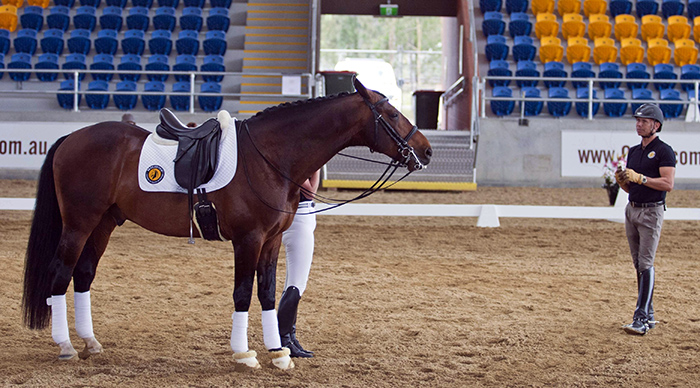
“Steffen, I would really like you to get on my horses and help me clarify my connection.” “Great, let’s do it.”
Steffen on Bean
Dolly: “You’ve told me to put my leg on and hold it for a couple of seconds, instead of giving him a kick. He goes forward and then comes straight back. Maybe I’m not being clear enough and I am getting really sore legs, so I am not very effective either.”
Steffen: “This is where you really need to have the strength in your core to make the impact for a couple of seconds so your horse knows you really mean business. You look pretty fit Dolly and I’m sure you are strong enough, but I can’t emphasise enough how important it is to be an effective rider to be mentally and physically fit and strong. I work out three times a week with a trainer at the gym, I also play tennis and ride a bike. It is not enough for our horses to be fit, strong and supple, we as riders must be as well if we want to get the best out of our horses.”
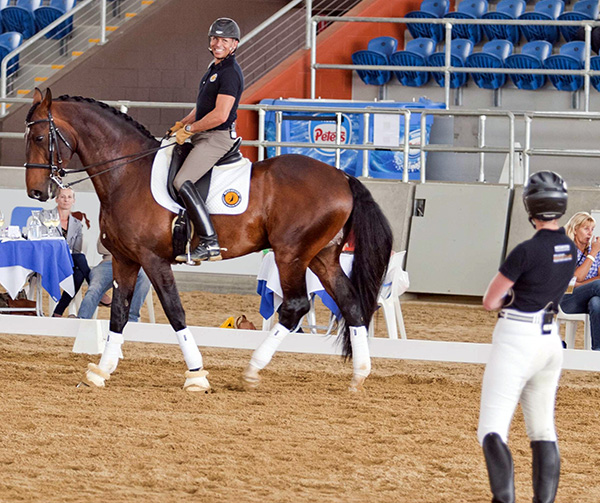
Steffen spends the next ten minutes working with Bean to reinforce the idea of the leg as a driving aid. He explains to Dolly that he has to engage Bean’s brain to respond immediately to the driving aid and stay in the tempo or gait until a new aid is given.
Steffen reinforces the idea that connection starts with the leg aid, which creates energy that is transferred from the horse’s hind quarters over his back down the neck to the mouth; this then travels back up the reins to the hands which receive the energy.
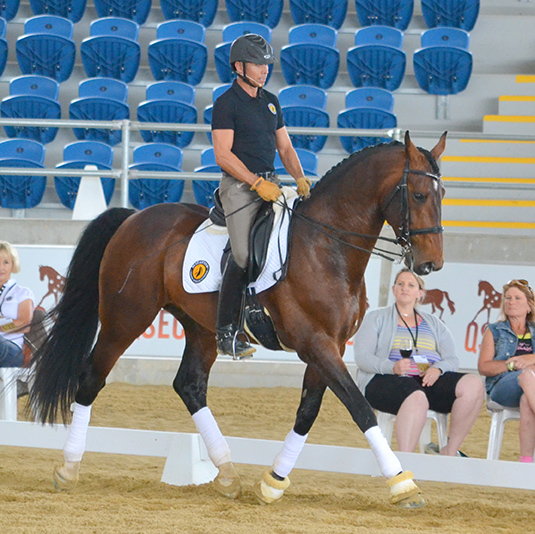
Correct contact can only be achieved through successfully working through each of the preceding levels of the classical training pyramid. When things go wrong in training a successful strategy is often to simplify matters by going back a step and establishing the basics. Ensure that the horse is moving forward in a steady rhythm in all three gaits, then work on suppleness and relaxation. When both of these steps are working well the horse will naturally stretch forward, round and down into contact. If a horse works well in respectful contact on one rein but not so well on the other, the issue most likely lies in the horse’s suppleness on one rein. Work done now on the stiff side will be far more productive than trying to attempt more advanced collection and impulsion on the looser side. Becoming an intelligent rider involves a good understanding of theory, the horse’s anatomy and possessing the analytical skills to ‘unpack’ a problem. Improving your horse means being constantly prepared to examine a situation and address the training gap. Go back, solidify the basics and make haste slowly.
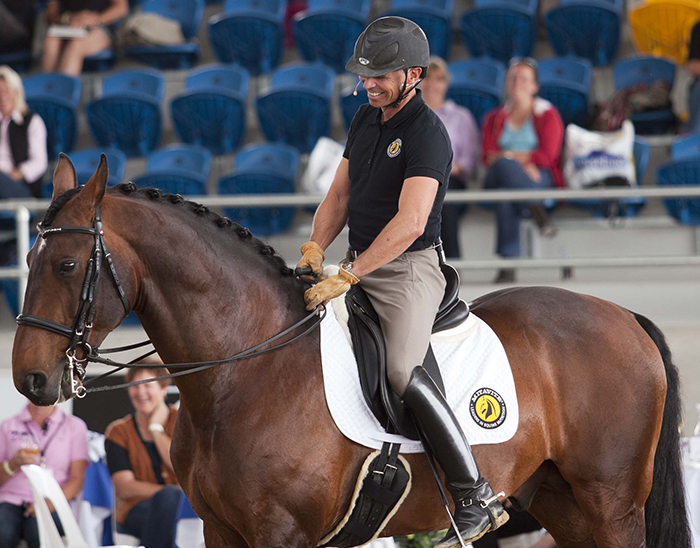
Jonah on Correlation, Causation & Superstition
The fundamental error that all athletes make is that they blame fear and anxiety for why they didn’t perform well. They make a causal relationship between fear and performance. That is, they believe the poor outcome was caused by their fears prior to performance. However, it is not a causal relationship it is one of correlation; they are making a correlation between the fear and anxiety and the resultant outcome. In theory, these two factors are easy to distinguish from each other. An action or occurrence can cause another (smoking causes cancer), or it can correlate with another (smoking is correlated with alcoholism). Smoking does not cause alcoholism and there are alcoholics that don’t smoke but statistically there is a very strong relationship correlation between the two.
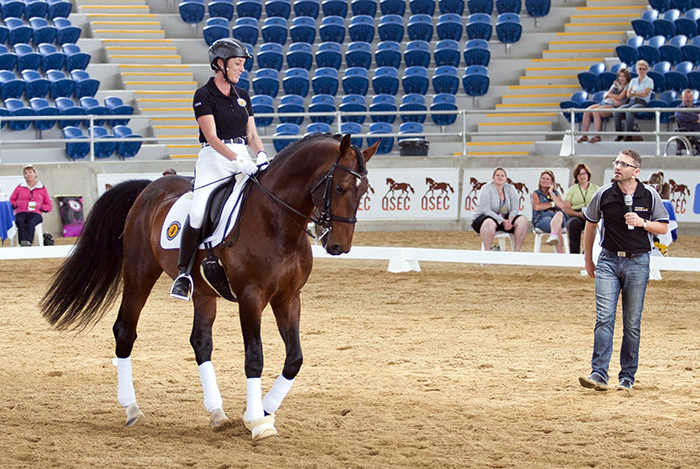
Jonah: “Ok Dolly what do you worry about when you ride in the competition arena?”
Dolly: “I have a fear of getting frustrated during the test, not remembering one of the moves, or something going wrong with the way we ride.”
Jonah: “Let’s look at the consequences, how does this make you feel when you make a mistake, or the unexpected happens.”
Dolly: “Like an idiot, embarrassed.”
Jonah: “Right and that’s very important to understand. What is the strongest response performance anxiety brings? For some people it is embarrassment, for some others it is anger or even sadness, but embarrassment or the fear of embarrassment is where performance anxiety often begins. The feeling of ‘I don’t want to feel humiliated’ is often followed by embarrassment and self-criticism to sadness and finally anger and this can all happen quite quickly.”
Dolly: “There is so much fear prior to riding a test, and then you ride out, finish and the fear is gone and I think I wish I could do it again, now that I am calm, but then it is too late.”
Jonah: “Right, I wish I could ride without fear. So what does this tell you about your relationship with fear?”
Dolly: “That it’s not good, it’s not helping me.”
Jonah: “This is a really important relationship to understand, so let’s talk about correlation and causation. A fundamental error that all athletes make is that they blame fear and anxiety for why they didn’t perform well. They make a causal relationship between fear and performance. It’s not causal, it’s correlational. I was feeling fearful, therefore I chose to change the way I rode, therefore I didn’t ride well. It’s the same for superstitions.”
Dolly : “Yes I have those, I can’t ride in anything new.”
What really caused the rain?
Jonah: “Let’s talk about that. Let’s talk about an analogy of the ancient native Indians that do a dance for rain and then one day it actually rains, well they say ‘it must be because we did the dance.’ So for 3,000 years they do the rain dance. It’s funny how 90% of the time it doesn’t rain, ‘well we can just ignore that because we did the dance and when it does rain, well it will because of the dance.’ I put my left boot on before my right and I rode well, I’d better keep doing that, that’s easy, I can control that. What purpose does this superstitious behaviour serve? When I do it (the behaviour) I feel better, more confident and I know it’s probably a bit silly but then that lingering thought pops into the back of your mind, what if I don’t do it, it’s not worth the risk when it’s so easy to control. So here is a really important point. Every time you engage in superstitious behaviour you are actually feeding your anxiety, you are making it worse; not the same, not better, but worse. You are reinforcing the behaviour that says, Nerves are bad, I must get rid of my nerves, I can only ride well when I’m calm.”
“Dolly I want you to learn how to ride with nervousness. What is the likelihood that you will be nervous riding your test in front of Steffen and the audience?”
Dolly: “Huge, it’s going to be huge.”
Jonah: “How about we make some space for that right now, to expect it. So when it shows up we won’t be surprised. We need to stop and say, it’s ok to have butterflies, lots of adrenaline, my brain becoming busy. Rather than find behaviours and superstitions to try and suppress anxiety, make some space for it, accommodate it. When was the last time you were calm riding a test? Do you think Steffen gets nervous?”
Dolly: “Steffen’s a legend, when you see Steffen ride Ravel in such beautiful harmony it’s hard to imagine that person, riding in such a way, can experience what I experience.”
Jonah: “What Steffen does really well is that he doesn’t act on his nerves. It doesn’t mean that what is going on in his head and the adrenaline moving through his body isn’t there; it’s just that he has learnt over time to accept that it will be there and move through it. However, when you see him on the TV it is easy to make the fundamental error that he must be calm, confident and composed. So the task for you now Dolly is to focus on your nervous energy, just like I have to.”
Dolly: “But you seem so calm talking in front of a large crowd and working with Steffen.”
Jonah: “It is exactly the same for me; my heart rate increases, I have to deal with nerves, I know I am a competent public speaker but do you want to put your fingers on my pulse right now and feel what it is?”
Dolly: “What would be the best way to deal with that, how do we reduce our anxiety and fear?”
Jonah: “We don’t want to try to reduce our fear, we most likely couldn’t even if we tried. What we want to do is change our focus, change our old habits into new productive ones. Fear is future focused, fear of what will or might happen. Instead we have to stay in the now, that is what is happening now. Stop your mind racing forward in panic and anxiety; bring it into the ‘now’ by focusing on simply hearing your breathing for a short time. The last time you rode an important test Steffen were you totally calm?”
Steffen: “Never, I always have some anxiety before riding a test, but I have learnt not to let the nervous adrenaline affect my performance by not changing the way I ride in a test.”
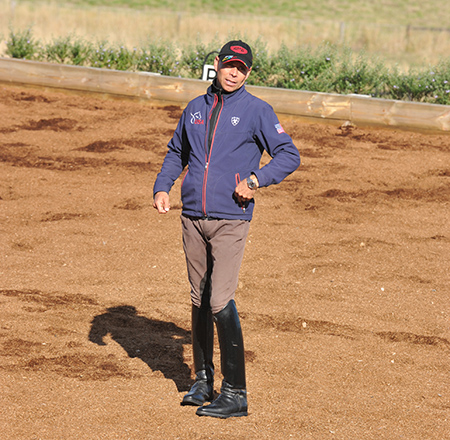
Steffen on Olympic nerves & anxiety
“I would really like to comment on this topic of feeling nervous in the competition arena; even if I come across calm, you honestly need to understand that it’s a procedure for me. I still remember in 1996 it was my first time ever representing the United States and I don’t want to forget that moment. It was our National Championships and we had eight riders and eight horses that had the potential of making the team. We couldn’t predict beforehand who would make it, sometimes you can but we all had the potential; after the first day I was in fourth place and after the second day I was now tied in fourth place with another rider. It came down to the very final test; the first two were in the team but the second two were undecided, it came down to the freestyle.”
Udon – Steffen’s first Olympic horse, Atlanta 1996 / Photo: Arnd Bronkhurst
“There was obviously a tremendous amount of pressure, but I learnt early on to rely on what I had done before in the warm up. I knew what I could do with my horse and I tried to do just exactly that and not more. Just because it was now a hugely important day, I didn’t try and go out there to ride the scoreboard, I simply rode my horse. Even though I was nervous at the time I dealt with it and I will never forget the moment when I made the team, I was very happy that I was on the team and then I said to myself, oh my god, I am representing my country. I am going to the Olympic Games and I’ll never forget that next step from doing well at the National Championships and going to my first Olympic Games, that was a huge stepping stone.”
“Then Ravel came along… um… sorry [Steffen wipes his eyes]… you’ll have to excuse me, every time I mention his name it is still a little bit difficult for me to talk about it. I still remember this; we came up at the World Cup 2009 in Vegas as No 1 and had now made it into the group of horses and riders that have the potential of winning a medal at the Olympics so now there was a whole new level of pressure again. The expectation was so much higher, it was no longer good enough just to be a participant it was expected that you would be in the top three.”
“We went to Aachen in 2010 and everybody said, ‘you are stupid to go over there, now you are going into the lion’s mouth, why would you do that? You’ve just won the World Cup.’ I said, ‘look I don’t want to hide, I really want to go for it, I want to compete with the Europeans and I’d really like to do it again.’ Then Ravel won Aachen and the World Games [Kentucky World Equestrian Games 2010] had come around at home in our country, the pressure increased even more. Not winning a medal in Kentucky would have been a failure to a lot of people, so the pressure keeps rising and rising. Coming across calm, that’s fine, but I guarantee you my blood pressure was way, way up there. But I knew, because of previous experiences, that my decision making and my priorities do not change. It comes right back to what Jonah was talking about previously: I don’t need to be confident – I need to be competent; I ride in the warm up the way we have trained and then ride the test in exactly the same way.”
